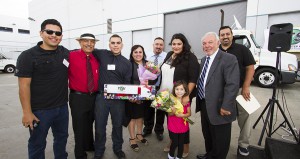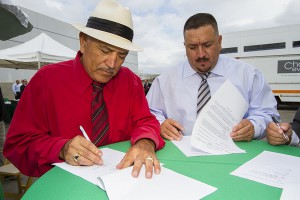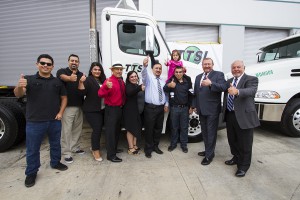 According to recent U.S. Census data, California has the highest percentage of people living below the official poverty rate. Obviously, no one wants to be poor, so what is the secret? I have said it before and I will say it again – the “secret” to success is to own your own business and have a good plan. In trucking, to “own your own business” typically means becoming an owner operator, but due to the new clean-truck regulations and pressure from unions, owner operators are becoming a dying breed at the ports of Los Angeles and Long Beach – and if it were up to the unions, they would all be gone already. But, owner operators can still succeed in today’s situation at the ports.
According to recent U.S. Census data, California has the highest percentage of people living below the official poverty rate. Obviously, no one wants to be poor, so what is the secret? I have said it before and I will say it again – the “secret” to success is to own your own business and have a good plan. In trucking, to “own your own business” typically means becoming an owner operator, but due to the new clean-truck regulations and pressure from unions, owner operators are becoming a dying breed at the ports of Los Angeles and Long Beach – and if it were up to the unions, they would all be gone already. But, owner operators can still succeed in today’s situation at the ports.
As you may be aware, there is a lot of bad press about the owner operators that work in the port. If you listen to the labor unions, they would have you believe that they are oppressed and being used by the big drayage companies as pawns. Well, if you think that is true, I urge you to read the rest of this article, written by an old friend of mine, Bill Mongelluzzo of the Journal of Commerce, highlighting a recent milestone reached at the port that proves that the owner operator model can still exist in today’s clean truck environment.
Five years after the ports of Los Angeles and Long Beach launched the industry’s most comprehensive new clean truck program, a father-and-son driving team became the first independent contractors to purchase an environmentally-compliant truck off of a lease. The event is significant for other U.S. ports because it confirms a business model in which drayage companies, their customers, and independent truck drivers can collaborate to replace a fleet of old, polluting trucks with new vehicles that are 90% cleaner.
 Vic La Rosa, president and CEO of TTSI in Rancho Dominguez, CA, recently handed over the keys of a truck that Jorge Gomez and his son, also named Jorge, had been leasing since 2009 as independent contractors. The truck complies with the standards in the Los Angeles and Long Beach Clean Truck Program, which the ports implemented back on October 1, 2008. The California Air Resources Board (CARB) Drayage Truck Program, which will take effect statewide on January 1, 2014, has the same standards. La Rosa said that other independent contractors will soon be reaching the time when they also will be able to purchase the trucks they have been leasing, not only at TTSI, but at other Southern California drayage companies, as well.
Vic La Rosa, president and CEO of TTSI in Rancho Dominguez, CA, recently handed over the keys of a truck that Jorge Gomez and his son, also named Jorge, had been leasing since 2009 as independent contractors. The truck complies with the standards in the Los Angeles and Long Beach Clean Truck Program, which the ports implemented back on October 1, 2008. The California Air Resources Board (CARB) Drayage Truck Program, which will take effect statewide on January 1, 2014, has the same standards. La Rosa said that other independent contractors will soon be reaching the time when they also will be able to purchase the trucks they have been leasing, not only at TTSI, but at other Southern California drayage companies, as well.
This development is an important victory for the harbor trucking companies in Southern California that have argued since the beginning of the Clean Truck Program that they could maintain an owner operator fleet while, at the same time, giving the drivers an opportunity to eventually purchase the trucks. Opponents of this business model, led by the Teamsters, had charged that in the highly-competitive harbor trucking industry, freight rates were too low to allow independent contractor drivers to properly maintain and eventually purchase the new generation of low-emission rigs. The Teamsters union, which has been attempting to organize drivers at the nation’s container ports, said a successful Clean Truck Program must be based on the model of financially-sound drayage companies purchasing the trucks and hiring the drivers as direct employees.
La Rosa said that the Southern California business model could not have succeeded without the cooperation of cargo interests such as Target Corp. Rick Gabrielson, senior director of international transportation at Target Corp., described the arrangement as a three-legged stool that includes the trucking company, the customer and the driver. Gabrielson is also president of the Coalition for Responsible Transportation, an organization of retailers and other cargo interests that have agreed to work with trucking companies and drivers at other ports seeking to implement Clean Truck Programs. Under this business model, the cargo interest agrees to pay a higher freight rate, which the drayage company combines with its own financial contribution, so that the driver can lease the truck, afford maintenance and other costs, and eventually buy it.
 For many years, the harbor was known as the place where rigs went to die. Long-haul truckers sold their high-mileage trucks to the local owner operators for as little as $10,000 to $20,000. The container-hauling independent contractors that bought these older trucks did much of the maintenance work themselves. Today’s highly-sophisticated vehicles cost $100,000 or more, and with their extensive computerization must be maintained and repaired by professional mechanics. Labor unions, environmental groups and community organizations believed that the new regime called for a business plan in which the large, financially-sound companies would purchase the trucks and employ unionized drivers.
For many years, the harbor was known as the place where rigs went to die. Long-haul truckers sold their high-mileage trucks to the local owner operators for as little as $10,000 to $20,000. The container-hauling independent contractors that bought these older trucks did much of the maintenance work themselves. Today’s highly-sophisticated vehicles cost $100,000 or more, and with their extensive computerization must be maintained and repaired by professional mechanics. Labor unions, environmental groups and community organizations believed that the new regime called for a business plan in which the large, financially-sound companies would purchase the trucks and employ unionized drivers.
CARB board member Hector de la Torre said harbor drayage companies in Los Angeles and Long Beach have confirmed the viability of the owner operator model with every one of the 11,000 trucks now running in the harbor that are compliant with local and state requirements. La Rosa said TTSI’s next goal is to operate trucks that approach zero emissions. “Our mission is far from over,” he said. TTSI is working with a local manufacturer to test trucks with fuel cell and battery technology that one day may be able to withstand the rigors of harbor drayage while emitting virtually no harmful emissions.

1 Comment
Interested in the Lease Purchase Program.